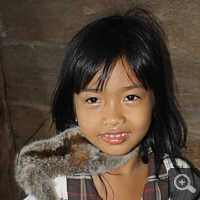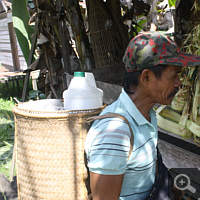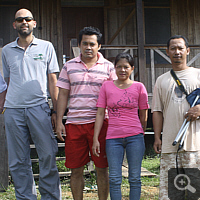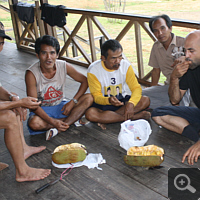Dayaks: Tribe of headhunters
The jungle was for them the centre of the world, trees sources of strength.

Who are the Dayaks?
The Dayaks are the indigenous population (native inhabitants) of Borneo. It is a collective term for several dozen tribes, which have partly their own language, culture and rites and which are distributed on whole Borneo.
The Dayaks belong to the Austronesian nations. It is believed that the ancestors of the Dayaks originate in the South Chinese area and colonized from there Southeast Asia in the mid of the 3. millennium before Christ. Many Dayak tribes speak also today their own languages, which belong to the Malayan-Polynesian branch of the Austronesian language family.
Historical information
In the 19th century the Dayaks were notorious in Europe. Some Dayaks acted as pirates, so that they came again and again into conflicts with the colonial powers. The Dayaks became known as tribe of headhunters. In some tribes existed the ritual to decapitate enemies during battles and to take along the head as war trophy.
The Dayaks gained further prominence because of their partly uncommon body decoration, which reached from tattoos to ampallangs (a kind of penis piercing) to earlobes distinct extended by weights. Especially the latter is still today to be found in some isolated living Dayak tribes (for example in Tering Baru).
Culture and religion
First most Dayak tribes lived as hunters and gatherers within the rainforest. Later many Dayak tribes proceeded to a life as settled rice farmers along rivers. Also today both life styles are to be found. Unchanged exist in difficult accessible primary rainforest tribes, which pursue hunting. However, most tribes live as settled rice farmers.
The Dayaks fellow originally animistic natural religions, because of missionary work many tribes converted to Christianity or Islam in the last century. Because the Indonesian state only accepts religions of the book, non-converted tribes declare their faith as Kaharingan, which rivals a variant of Hinduism.
Transmigrasi: One reason for rainforest destruction
Indonesia is a multiethnic state, which has to cope with two important geographical problems. On the one hand Indonesia consists of circa 13.000 islands, of these are circa 3.000 islands permanent inhabited. In addition Indonesia spans 5.100 km in west-east-direction and almost 1.900 km in north-south-direction. A further problem is an imbalanced distribution of population. In Java population density is with 800 inhabitants per square kilometre circa four times as much as in in Germany. On the contrary are islands to be found, which are only sparsely settled.
To equate the distinct population density on the one hand and to prevail against native inhabitants of the peripheral islands on the other hand, to force them on the Javanese „dominance culture“, in 1969 the transfer programme Transmigrasi was started under dictator Suharto. With a promise for land ownership (2 ha per family), a house, stocks of food for one year and seeds 1,7 millions families with all in all 6,8 millions people joined in the transfer programme by 1994.
In 1969 Borneo was almost arboreous at 100%. The programme Transmigrasi led within the following decades to a giant deforestation as well as drainage of the swamps, to convert these areas for agriculture. Today former forests are only fragmentary preserved in the south of Borneo.
The Javaneses were considered by the Dayaks as modern conquerors. In the end the Dayaks were withdrawed living space, they lost hunting and fishing rights. Against this background, several bloody conflicts between Daykas and immigrants are explained.
Today Transmigrasi must be consider as failed. The programme led to a giant enviromental destruction, changed significantly Dayaks and drove many immigrants into poverty, after they had failed because of insufficient skills in agriculture. At latest the basic aim, namely to homogenise the distinct population density, wasn’t achieved.
Current situation
Today mostly natural-living Dayak tribes are only to be found in few accessible regions with primary rainforest. Many Dayaks have abandoned great parts of their culture. Some Dayak tribes still lead a life as rice farmers.
In the Meratus region were many rainforest villages abandoned within the last decades. The Dayaks moved alongside logging tracks and partly earn a crust as logger or truck driver. Also in other regions many Dayaks have abandoned their old lifestyle and lead meanwhile a modern life in larger towns.
Situation in Tanjungsoke
Tanjungsoke is a classic village with circa 250 inhabitants, who belong all to the Dayaks. The village consits of small houses in pile-dwelling structure, which are grouped around a central village square. A classic longhouse, in which the whole village community lives, doesn’t exist. Just as little the above mentioned body decoration of the Dayaks is to be found in the village.
In Tanjungsoke the Dayaks ply predominantly farming. Mainly is rice cultivated (in dry culture, i.e. fields are not waterlogged). In addition are several vegetables cultivated (mainly: corn, pumpkin, aubergine, bitter gourd, flowering cabbage, celery cabbage). Because of nutrient-poorness of rainforest soils a field has to lie idle for ten years, before it can be under cultivation again. Thus the Dayaks fell small areas of rainforest of circa 1 ha size, which they alternately farm. Except water buffaloes and some chickens no animals are reared. Fishing is distributed, single inhanitants pursue hunting.
In the last years occured a distinct technization of the village. Single inhabitants work for logging companies and can afford mopeds. Almost every household have available a diesel generator, which delivers electricity at least hourly. Almost every second house is equipped with a television and a satellite dish. The first mobile phones were as well in evidence.
In den letzten Jahren fand eine deutliche Technisierung des Dorfes statt. Einzelne Dorfbewohner arbeiten für die Holzfällergesellschaften und können sich Mopeds leisten. Nahezu jeder Haushalt verfügt über einen Dieselgenerator, der zumindest stundenweise Strom liefert. Nahezu jedes zweite Haus ist mit einem Fernseher und einer Satellitenschüssel ausgestattet. Die ersten Handys sind ebenfalls zu sehen.




